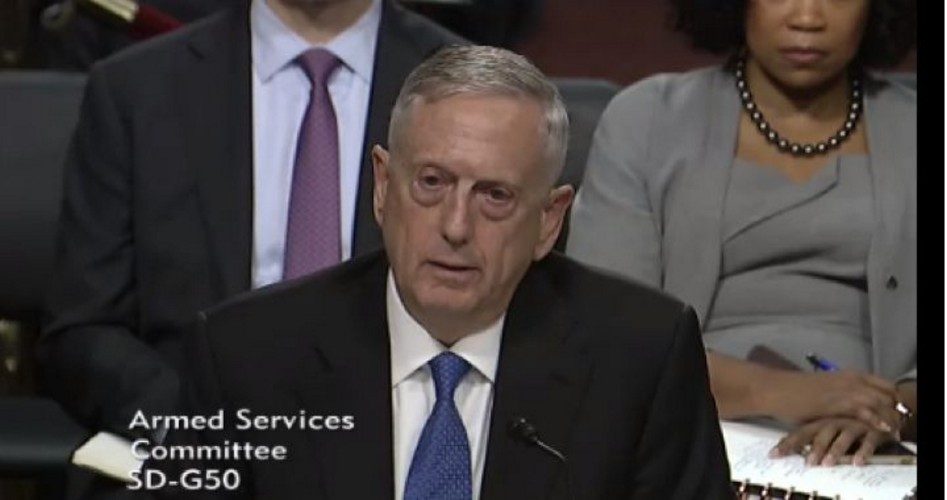
During testimony on June 13 before the Senate Armed Services Committee in support of President Trump’s Defense Department budget request for Fiscal Year 2018, Defense Secretary James Mattis (shown) asserted, “We are not winning in Afghanistan right now. And we will correct this as soon as possible. I believe by mid-July we will be able to brief you in detail.” Mattis’ statement was made during a tense exchange with the committee’s chairman, John McCain (R-Ariz.).
McCain, one of the Senate’s most outspoken interventionists on foreign policy, expressed noticeable frustration with what he perceives as a failed U.S. military strategy in Afghanistan, telling Mattis during the hearing, “We’re now six months into this administration. We still haven’t got a strategy for Afghanistan. It makes it hard for us to support you when we don’t have a strategy. We know what the strategy was for the last eight years: Don’t lose.”
The Arizona senator also warned Mattis that senators will “start getting more vocal in our criticism” if a plan isn’t delivered soon.
“I was confident that within the first 30 to 60 days [of the administration] we would have a strategy from which to start working,” McCain said. “So, all I can tell you is that unless we get a strategy from you, you’re going to get a strategy from us.”
A report from Politico stated that the United States has approximately 8,400 troops in Afghanistan. However, the top U.S. commander in Afghanistan, Army General John Nicholson, has said that several thousand more are needed to support the Afghan security forces.
Sentor Roger Wicker (R-Miss.) asked Mattis to “define for us what winning in Afghanistan means.”
“What does winning look like?” Mattis answered. “The Afghan government — with international help — will be able to handle the violence and drive it down to a level that local security forces can handle it.”
Still, “With our allies, it would probably require residual force doing training and maintaining the high-end capability” to take out security threats, Mattis said. “It’s going to be an era of frequent skirmishing, and it’s going to require a change in our approach from the last several years if we’re to get it to that position.”
While the Trump administration may not be going fast enough in developing a more “winning” strategy in Afghanistan for McCain’s liking, it is apparent that the hawkish McCain’s disagreement with Mattis and Trump is more over timing than major substantive points, including whether U.S. troops should be in Afghanistan at all. This is mainly a disagreement between different interventionists.
That the Trump administration is committed to continuing intervention in Afghanistan was indicated by a report in the New York Times on June 13 that cited a statement from three unnamed administration officials who said that Trump has given Mattis the authority to determine troop levels in Afghanistan, presumably opening the door for sending more U.S. forces there.
The Times article referred to the exchange between Mattis and Trump during the committee hearing that day, noting that Mattis sought to ease McCain’s concerns “by hinting that some troops might be sent as an interim step before the administration’s new strategy is finalized.”
“There are actions being taken to make certain that we don’t pay a price for the delay,” the Times said, quoting Mattis’ assurance to McCain.
After quoting the defense secretary’s assessment — “The Taliban had a good year last year, and they’re trying to have a good one this year. Right now, I believe the enemy is surging” — the Times writer observed that the main question before the administration is how to reverse the unfavorable trends on the battlefield.
The report cited a statement made by General Nicholson in February saying that he needed a “few thousand” more troops.
The report went on to state that the Pentagon later developed a plan to send 3,000 to 5,000 more U.S. troops to Afghanistan, including hundreds of Special Operations forces. More troops would be contributed by other NATO nations.
We observed in a May 31 article, “Kabul Bomb Blast Could Be Used to Justify Increase in U.S. Troops in Afghanistan,” that as the Trump administration — like the previous Obama and Bush administrations — considers whether to increase the U.S. troop presence in Afghanistan, we might review why our troops were sent there in the first place, and whether that was a good decision. Furthermore, we should question why we still have troops there almost 16 years later. We recalled the reason why our nation sent troops to Afghanistan originally, noting that we invaded the country in October 2001 in response to the Taliban government’s refusal to hand over Osama bin Laden, the founder of al-Qaeda and supposed mastermind of the September 11 terrorist attacks.
Though the invasion wrested control of most of the country from the Taliban, bin Laden fled the country and went into hiding in Pakistan until captured and killed by U.S. special forces in 2011. The Taliban were driven from the country’s major population centers and a new government led by Hamid Karzai was installed with U.S. support. However, toward the end of Karzai’s term, the Taliban reorganized and began to control more of the country. They have continued to wage an insurgency against the central government ever since.
However, with bin Laden gone from this Earth, our reason for going there has long disappeared, and intervening in Afghanistan’s internal conflict is not the responsibility of the United States.
For years after the initial U.S.-led invasion, former Representative Ron Paul (R-Texas), the leading non-interventionist in Congress, continually noted that no war had been constitutionally authorized within Afghanistan — only the use of force against those responsible for the 9/11 attacks.
Paul retired from his House seat in 2013, but has continued to voice his opinions about U.S. foreign policy on a regular basis. His son, Rand Paul, became a U.S. senator representing Kentucky in 2011 and also has been outspoken on foreign policy and other issues.
In an October 2015 interview with CNN’s Wolf Blitzer, the younger Paul — who was a presidential candidate at the time — maintained that the United States should no longer be fighting the war in Afghanistan and that “the Afghans need to step it up and defend themselves.”
“I think this goes to a bigger question and this is the question President Obama should have to answer: Why are we still at war in Afghanistan? What is the U.S. objective, what’s the U.S. mission and why are we bombing anybody in Afghanistan?”
Paul — continuing the same argument his father had long used — said that while the United States “had a clear cut mission” in Afghanistan following the attacks of September 11, 2001, “that’s been long gone for many years now.”
Paul’s 2015 commentary is still relevant: “Why are we still at war in Afghanistan?”
It is now time to ask the same question of President Trump.
Image of James Mattis: Screengrab of Senate Armed Services Committee meeting
Related articles:
Kabul Bomb Blast Could Be Used to Justify Increase in U.S. Troops in Afghanistan
Rand Paul Wants Senate to Vote on Trump’s Saudi Arms Deal
Obama Secretly Authorizes U.S. Combat Extension of Afghan War



